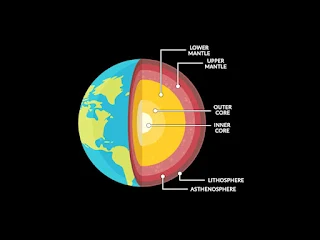Inner core of the Earth has been growing faster under Indonesia's Banda Sea and Brazil
Consistent with a replacement study, the solid-iron inner core of the world has been growing faster on one side than the opposite for over 500 million years.
It is growing faster under Indonesia's Banda Sea than under Brazil, but this uneven growth pattern hasn't left the core lopsided, say seismologists at the University of California, Berkeley, who are investigating the phenomenon.
Gravity has acted to evenly distribute the new growth, made from iron crystals that form as molten iron begins to chill, maintaining a spherical inner core density.
Even though it doesn't leave the core lopsided, this uneven rate of growth suggests something within the outer core under Indonesia is removing heat from the inner core at a faster rate than it's under Brazil on the other side of the earth, the team said.
Researchers say this discovery has helped them "prove rather loose bounds" for the age of the inner core, which is between half a billion and 1.5 billion years old.
This boundary for the age of the solid core of the world can help scientists learn more about the magnetic flux that protects us from harmful radiation.
We know the magnetic flux already existed 3 billion years ago, so other processes must have driven convection within the outer core at that point.
The young age of the inner core may mean that, early in Earth's history, the warmth boiling the fluid core came from light elements separating from iron, not from the crystallisation of iron, which we see today.
The complication is: if the inner core had been ready to exist just for 1.5 billion years, supporting what we all know about how it loses heat and how hot it is, then where did the older magnetic flux come from?
That is where this concept of dissolved light elements that then freeze comes from.
Asymmetric growth of the inner core, which is growing at different rates on all sides of the earth, explains a three-decade-old mystery, Frost explained.
The mystery is that the crystallised iron within the core appeared to be more likely to be aligned to the west than the east of Earth's rotational axis.
The team said scientists would expect the crystals to be randomly oriented rather than have them favour one side of the earth over the opposite.
To avoid the observations, they created a computer model of crystal growth within the inner core.
Their model incorporated geodynamic growth, how materials on earth deform and form, and therefore the mineral physics of iron at high and low temperatures.
Frost said the simplest model seemed unusual-that the inner core is asymmetrical.
The side looks different from the side thanks to the middle, not just at the top of the inner core, as some have suggested. The sole way we will explain that's by one side growing faster than the opposite. '
The model describes how asymmetric growth-about 60 per cent higher within the east than in the west-can preferentially orient iron crystals along the rotation axis, with more alignment within the west than within the east.
What we're proposing in this paper may be a model of lopsided solid convection within the inner core that reconciles seismic observations and plausible geodynamic boundary conditions, "Romanowicz said."
Earth's in its inner self is layered like an onion. The solid iron-nickel inner core is around 745 miles in radius, or about three-quarters of the dimensions of the moon. It is surrounded by molten iron at the outer core and nickel which is about 1,500 miles thick.
The outer core is surrounded by a mantle of hot rock 1,800 miles thick and overlain by a skinny, cool, rocky crust at the surface.
Convection within the outer core, slowly heated by crystallising iron, comes out of the inner core, and within the mantle, as hotter rock moves upward to hold this heat from the centre of the earth to the surface.
The vigorous boiling motion within the outer core produces the Earth's magnetic flux.
According to Frost's computer model, as iron crystals grow, gravity redistributes the surplus growth from the east toward the west within the inner core.
Moving of crystals within the inner core, on the brink of the freezing point of iron, aligns the space lattice with the Earth's rotational axis, doing so more to the west than the east, they found.
The model predicts the researchers' new observations about seismic wave travel times through the inner core.
The difference in travel times parallel and perpendicular to the rotation axis increases with depth.
The anisotropy is offset to the west from Earth's rotation axis by about 250 miles.
The model of inner core growth also provides limits on the proportion of nickel to iron within the centre of the world, Frost said.
His model doesn't accurately reproduce seismic observations unless nickel makes up between four percent and eight percent of the inner core.
This is on the brink of the proportion of metallic meteorites that were the cores of dwarf planets in our system.
The model also concludes of fluid, the inner core is.
"We suggest that the viscosity of the inner core is large," said Romanowicz.




